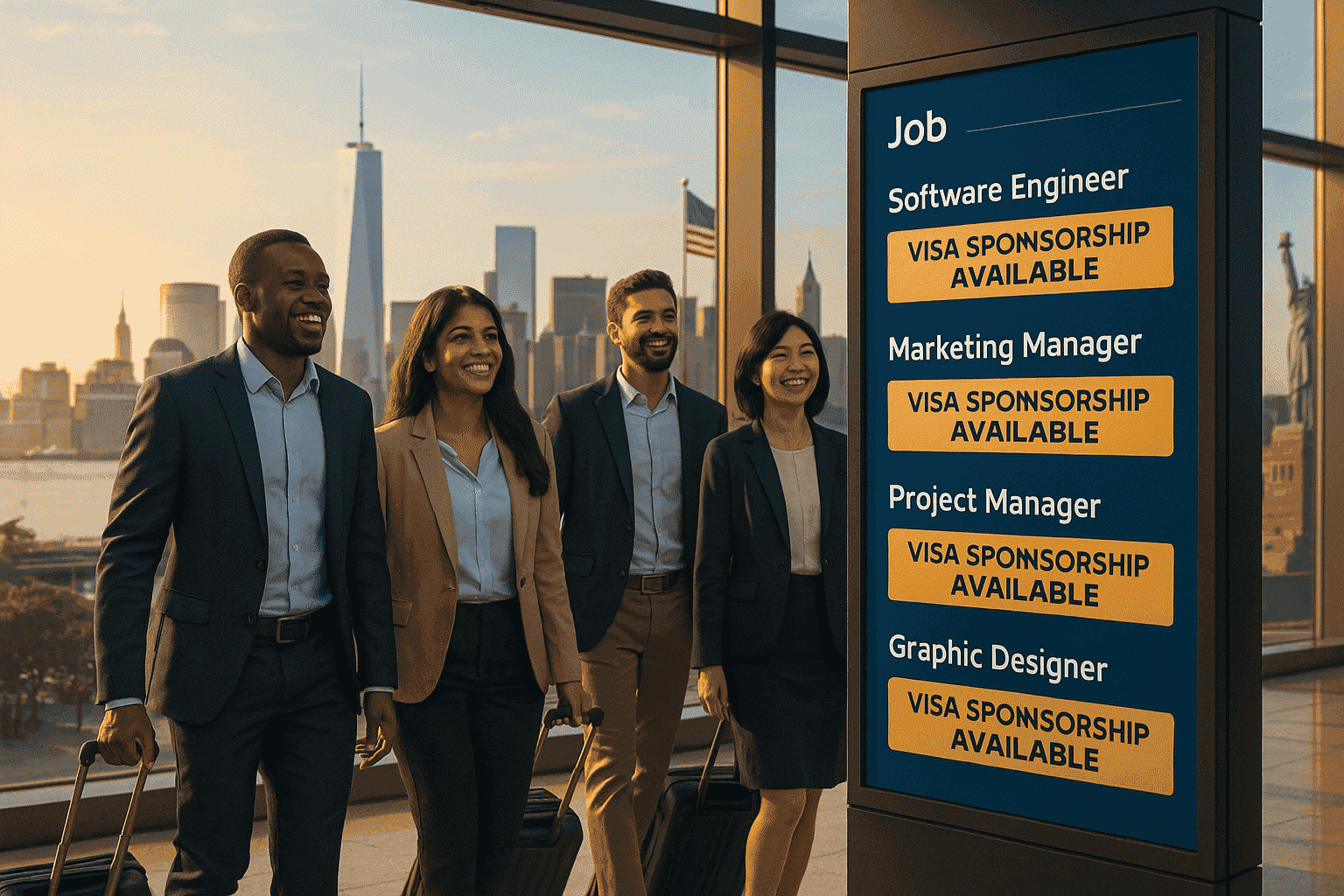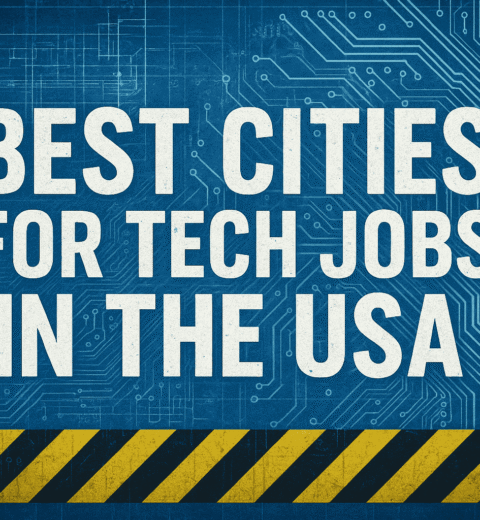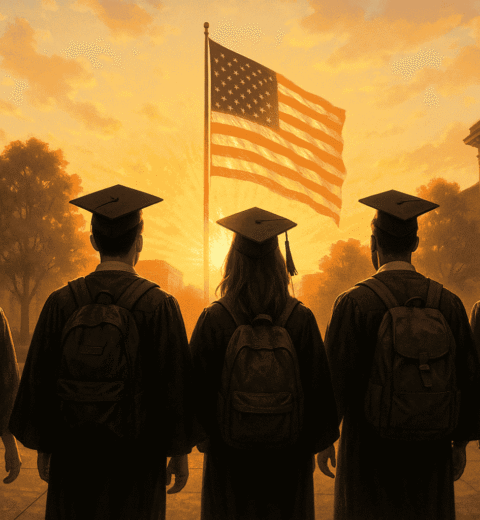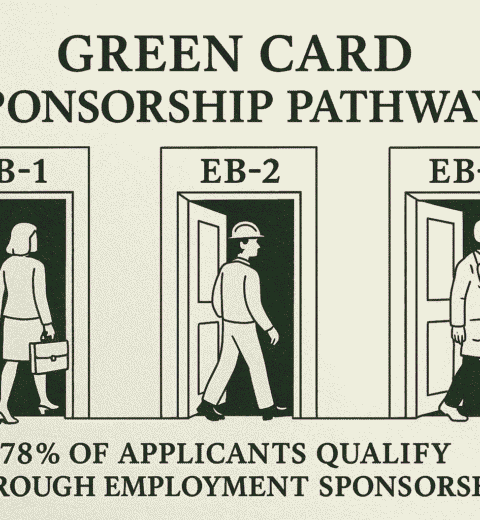Table of Contents
- Introduction to Jobs in the USA for Immigrants
- Current Job Market Trends for Immigrants in the USA
- Top Industries Hiring Foreign Workers
- Best Companies Offering Visa Sponsorship
- Types of Work Visas for Immigrants
- How to Find Visa Sponsorship Jobs in the USA
- Tips for a Strong Job Application
- Challenges Faced by Immigrants in the US Job Market
- Future Outlook for Immigrant Employment
- Frequently Asked Questions (FAQs)
Introduction to Jobs in the USA for Immigrants
For decades, the United States has been a beacon of opportunity for skilled professionals worldwide. With its thriving economy, cutting-edge industries, and competitive salaries, jobs in the USA continue to attract thousands of immigrants every year. But getting a job as a foreign worker involves more than just sending in a CV; it also involves negotiating the tricky realm of visa sponsorship, where companies are in charge of obtaining work permits for foreign personnel.
The good news? Many top-tier companies—particularly in technology, healthcare, and engineering—actively seek out global talent and are willing to sponsor visas for the right candidates. Whether you’re an international student wondering about work options after graduation or an experienced professional searching for Green Card sponsorship jobs in the USA, understanding the latest job market trends, employer expectations, and visa processes is essential for success.
In this comprehensive guide, we’ll explore:
- The most in-demand industries hiring immigrants in 2025
- Top companies known for offering visa sponsorship
- The latest US work visa policies and how they impact job seekers
- Proven strategies to improve your chances of securing a sponsored job
- Real-life challenges immigrants face and how to overcome them
By the end, you’ll have a clear roadmap to turning your American career dreams into reality.
Why Visa Sponsorship Jobs Are in High Demand
The U.S. job market is experiencing a critical skills shortage, particularly in specialized fields like software development, healthcare, and advanced engineering. Many American companies struggle to find qualified local candidates, making them more open to hiring skilled immigrants.
Key Factors Driving Demand for Foreign Workers:
- Tech Industry Boom—Companies like Google, Amazon, and Microsoft constantly compete for top-tier talent in AI, cybersecurity, and cloud computing. Since domestic supply can’t always meet demand, these firms heavily rely on H-1B visa workers.
- Aging Population & Healthcare Shortages—The U.S. faces a growing need for nurses, doctors, and medical technicians, leading hospitals and research institutions to actively recruit foreign professionals.
- Infrastructure & Engineering Projects—With massive investments in renewable energy, transportation, and smart cities, engineering roles in civil, mechanical, and electrical fields are increasingly filled by immigrant experts.
- Global Business Expansion—Consulting and financial firms like Deloitte, JPMorgan Chase, and McKinsey seek diverse talent to serve international clients, making them frequent sponsors of L-1 and EB-3 visas.
The Reality of Visa Sponsorship in 2025
While opportunities exist, the process isn’t without challenges. Visa backlogs, policy changes, and strict eligibility requirements mean job seekers must be strategic. For example:
- There is an annual lottery for H-1B visas, and there are only 85,000 spots available.
- Green Card sponsorship can take years due to country-specific quotas.
- Some industries (like healthcare and education) have faster visa processing due to labor shortages.
Understanding these nuances will help you target the right employers and maximize your chances of success.
How This Guide Will Help You Navigate the US Job Market
If you’re serious about securing a job in the USA with visa sponsorship, this guide is designed to give you:
✔ Up-to-date insights on the best industries and companies hiring immigrants
✔ Step-by-step advice on job searching, applications, and interviews
✔ Visa breakdowns (H-1B, L-1, EB-3, etc.) and which one fits your profile
✔ Success stories from immigrants who landed sponsored jobs
✔ Common pitfalls and how to avoid them
Whether you’re just starting your research or already applying for roles, this resource will help you stand out in a competitive market.
Looking for More Specific Guidance?
🔗 Can International Students Work in the USA After Graduation? – Learn about OPT, CPT, and STEM extensions for recent graduates.
🔗 Green Card Sponsorship Jobs in the USA 2025 – Discover companies that help employees transition from work visas to permanent residency.
Next up: We’ll dive into the latest job market trends shaping opportunities for immigrants in 2025.
Current Job Market Trends for Immigrants in the USA

2025 US Job Market Trends: Where Immigrants Are Finding the Best Opportunities
The American job market is undergoing a significant transformation in 2025, with skilled immigrants playing a crucial role in filling critical labor gaps. As companies struggle to find qualified domestic workers, foreign professionals—especially those in STEM fields (science, technology, engineering, and mathematics)—are seeing unprecedented demand.
If you’re searching for jobs in the USA with visa sponsorship, understanding these key trends will help you target the right industries and maximize your chances of success.
The Tech & IT Boom: America’s Biggest Visa Sponsorship Sector
The technology industry remains the most active recruiter of international talent, with giants like Google, Microsoft, and Amazon consistently ranking among the top sponsors of H-1B visas. But what’s driving this demand?
Why Tech Companies Are Desperate for Foreign Talent
- AI & Machine Learning Explosion—The rapid growth of artificial intelligence has created a massive need for data scientists, AI researchers, and machine learning engineers. US universities aren’t producing enough graduates to meet this demand, forcing firms to look abroad.
- Cybersecurity Shortages—With cyberattacks increasing, companies are scrambling to hire ethical hackers, cloud security experts, and compliance specialists. Many of these roles qualify for fast-track visa processing due to national security needs.
- Remote Work Flexibility—While most visa-sponsored jobs require relocation, some tech firms now offer hybrid roles, allowing foreign hires to work remotely part-time while maintaining US employment status.
Top In-Demand Tech Jobs for Immigrants in 2025
If you have expertise in any of these areas, your chances of securing a visa sponsorship job in the USA are exceptionally high:
✅ Software Development (Full-stack, DevOps, Blockchain)
✅ Data Science & Analytics (Python, SQL, Big Data)
✅ Cloud Computing (AWS, Azure, Google Cloud)
✅ Cybersecurity (Penetration Testing, Risk Management)
🔗 Wondering how to transition from a student visa to a work visa? Read our guide on Can International Students Work in the USA After Graduation?
Healthcare: The Fastest Path to US Employment for Immigrants
If you’re a doctor, nurse, or medical researcher, the US healthcare system wants you—badly.
Why Healthcare Visa Sponsorships Are Surging
- Aging Population Crisis—With 10,000 Americans turning 65 every day, the demand for geriatric care, physical therapists, and specialized surgeons has skyrocketed.
- Rural Doctor Shortages—Many small towns have zero practicing physicians, creating urgent openings for foreign medical graduates willing to work outside major cities.
- Faster Visa Processing—Unlike the H-1B lottery, healthcare workers often qualify for EB-3 visas or even National Interest Waivers (NIW), which bypass lengthy backlogs.
Best Healthcare Roles for Visa Sponsorship
🏥 Registered Nurses (RNs)—Hospitals nationwide are offering signing bonuses and Green Card sponsorship to attract foreign nurses.
🏥 Physicians—especially in internal medicine, psychiatry, and emergency care.
🏥 Biomedical Engineers – With medical tech innovation booming, companies need experts in prosthetics, surgical robots, and AI diagnostics.
Engineering & Infrastructure: Where Visa Sponsorships Meet High Salaries
The US is pouring billions into infrastructure projects, from smart cities to renewable energy grids—and they need skilled engineers to make it happen.
Why Engineering Jobs Are Immigrant-Friendly
- Specialized Skill Gaps—There simply aren’t enough American engineers trained in sustainable architecture, autonomous vehicles, or aerospace design.
- Government-Backed Projects—Many infrastructure jobs are tied to federal funding, which often prioritizes visa approvals for critical roles.
- High Salary Potential—Civil engineers with visa sponsorship routinely earn $90,000–$150,000, with faster paths to Green Card sponsorship.
Top Engineering Fields Hiring Foreign Workers
🔧 Civil Engineering (Bridges, Highways, Urban Planning)
🔧 Electrical Engineering (Smart Grids, EV Charging Networks)
🔧 Mechanical Engineering (Robotics, Automotive R&D)
🔗 Looking for permanent residency options? Explore Green Card Sponsorship Jobs in the USA 2025.
Key Takeaway for Job Seekers
The 2025 US job market is highly favorable for immigrants in tech, healthcare, and engineering. By focusing on industries with labor shortages, you can:
✔ Increase your chances of visa approval.
✔ Land higher salaries and benefits.
✔ Secure faster Green Card sponsorship
Next, we’ll reveal the top companies actively hiring immigrants in 2025—and how to get noticed by their recruiters.
Top Industries Hiring Foreign Workers

For skilled professionals looking to build a career in America, certain industries stand out as particularly welcoming to international talent. These sectors not only offer abundant job opportunities but also have established systems for visa sponsorship and career growth. Let’s examine each of these high-demand fields in detail.
Technology & IT Services: America’s Innovation Engine
The U.S. technology sector continues to experience explosive growth, creating thousands of jobs in the USA for foreign professionals each year. Major tech hubs like Silicon Valley, Seattle, and Austin are constantly searching for specialized talent that domestic graduates alone cannot provide.
Software development remains the most in-demand role, with companies particularly seeking experts in full-stack development, artificial intelligence, and cloud computing. Cybersecurity professionals are also in critically short supply, as businesses across all sectors scramble to protect their digital assets from increasingly sophisticated threats. Cloud architects who can design and maintain complex cloud infrastructure systems find themselves with multiple job offers, often with generous relocation packages.
What makes tech jobs particularly attractive for immigrants is that many companies have dedicated immigration teams to handle visa sponsorship. Firms like Google, Amazon, and Microsoft have become so experienced with the H-1B visa process that they can navigate it efficiently, making them ideal targets for international applicants.
Healthcare & Pharmaceuticals: Caring for America’s Future
The healthcare industry represents one of the most reliable paths to US employment for foreign workers. As America’s population ages and chronic conditions become more prevalent, the demand for medical professionals has reached unprecedented levels.
Registered nurses from abroad find particularly strong opportunities, especially those willing to work in underserved rural areas or major metropolitan hospitals. The nursing shortage has become so severe that many healthcare systems now offer sign-on bonuses, housing assistance, and guaranteed green card sponsorship after a few years of service.
Opportunities for doctors are particularly good in primary care areas like internal medicine, psychiatry, and family medicine. Biomedical engineers play a crucial role in developing new medical technologies and devices, with pharmaceutical companies and research institutions actively recruiting international talent in this field.
Engineering & Manufacturing: Building America’s Infrastructure
The recent infrastructure bill has created a surge in demand for engineering professionals across multiple disciplines. Large-scale water, energy, and transportation projects across the country require the design and supervision of civil engineers. Mechanical engineers find opportunities in automotive manufacturing, aerospace, and renewable energy sectors.
What makes engineering roles particularly appealing for visa sponsorship is that many projects receive government funding, which often comes with requirements to meet certain employment targets. This creates strong incentives for companies to sponsor foreign workers when they can’t find qualified American candidates.
Project managers with technical backgrounds and international experience are especially valued, as they can bridge cultural gaps in multinational engineering teams. The manufacturing sector also offers opportunities for industrial engineers and production specialists who can optimize factory operations.
Finance & Consulting: The Global Business Hub
Wall Street firms and major consulting companies have long recognized the value of diverse international perspectives in serving their global client base. Financial analysts with expertise in emerging markets or specialized financial instruments can find excellent opportunities with visa sponsorship.
Management consulting firms particularly value foreign professionals who understand business practices in multiple countries, making them ideal for advising multinational corporations. Actuaries with strong mathematical backgrounds and certifications find steady demand in the insurance and financial services industries.
These firms typically have well-established programs for bringing international talent to their U.S. offices, often through L-1 intracompany transfers or direct H-1B sponsorship. The competitive salaries and clear career progression paths make these roles particularly attractive for ambitious professionals.
For those considering their options, it’s worth exploring our guide on Green Card sponsorship jobs in the USA 2025 to understand long-term career pathways. International students may also want to review our article on Can international students work in the USA after graduation? to plan their transition from student visas to work authorization.
Each of these industries offers distinct advantages for foreign workers, from competitive compensation packages to clear paths for career advancement. By focusing your job search in these high-demand sectors, you significantly improve your chances of finding an employer willing to sponsor your visa and invest in your American career journey.
Best Companies Offering Visa Sponsorship
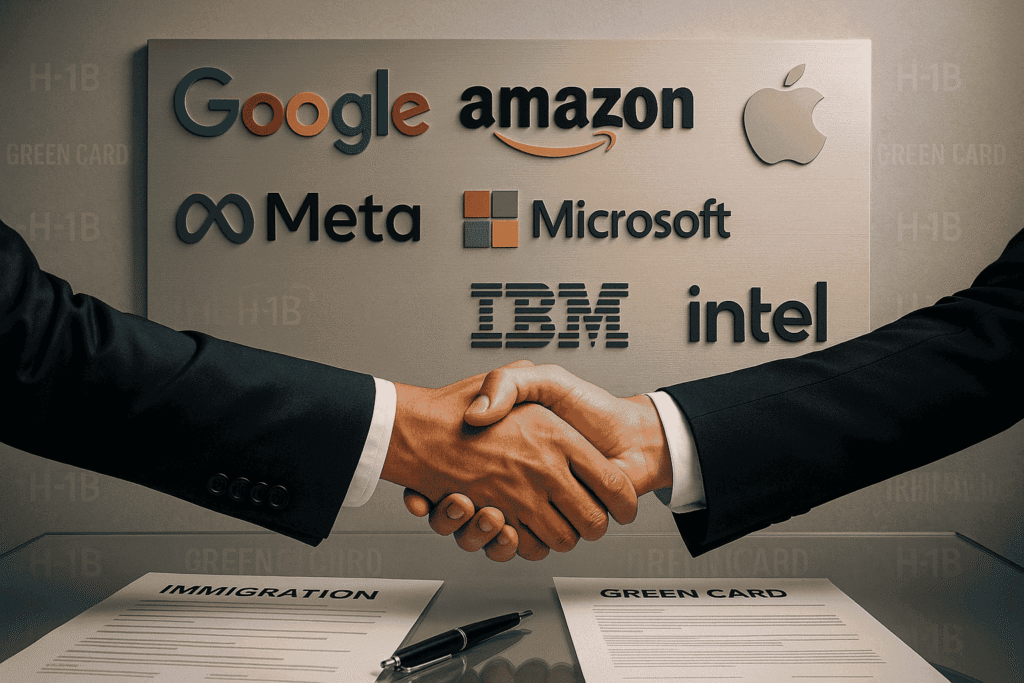
For international professionals seeking jobs in the USA with visa sponsorship, targeting the right employers can make all the difference. These industry-leading companies not only hire foreign talent but also have established immigration programs to help navigate the complex visa process.
Technology Titans: Where Innovation Meets Global Talent
Google continues to be one of the most sought-after employers for foreign tech professionals. The search giant sponsors hundreds of H-1B visas annually for roles ranging from software engineers to AI researchers. What sets Google apart is their dedicated immigration team that handles everything from initial visa petitions to eventual green card sponsorship, making the transition to US employment smoother for international hires.
Amazon’s massive workforce includes thousands of visa holders across their e-commerce and AWS cloud computing divisions. The company is particularly known for its streamlined process for TN visa candidates from Canada and Mexico while also being one of the top H-1B sponsors. Amazon’s “Path to Green Card” program helps high-performing employees transition from temporary work visas to permanent residency.
Microsoft maintains one of the most robust visa sponsorship programs in the tech industry. Beyond standard H-1B processing, they offer specialized support for international students transitioning from OPT to full-time employment. Their Redmond headquarters has become a global hub where employees from dozens of countries collaborate on cutting-edge software development.
Healthcare Leaders Committed to Global Recruitment
Johnson & Johnson stands out in the healthcare sector for its comprehensive approach to hiring international medical professionals. The pharmaceutical giant regularly sponsors H-1B visas for research scientists and EB-3 green cards for clinical specialists. Their global mobility program helps foreign employees with relocation, cultural adaptation, and long-term career development in the US healthcare market.
Consulting Firms with International Reach
Deloitte’s global consulting practice makes them particularly receptive to hiring foreign professionals. The firm utilizes both H-1B visas for new hires and L-1 visas for internal transfers from their international offices. Deloitte’s “Global Mobility Services” team specializes in helping international employees navigate complex visa requirements while advancing their consulting careers.
These businesses are but a selection of those that are actively seeking for foreign talent. Other notable employers with strong visa sponsorship programs include
- Apple (technology)
- Tesla (automotive/energy)
- Pfizer (pharmaceuticals)
- Goldman Sachs (financial services)
- Boston Consulting Group (management consulting)
Each of these employers has demonstrated consistent commitment to hiring international professionals through their visa sponsorship track records and dedicated immigration support teams.
For international students exploring their options, our guide on Can international students work in the USA after graduation? provides crucial information about transitioning from student visas to employment. Those looking for permanent residency pathways should review our comprehensive article on Green Card Sponsorship Jobs in the USA 2025 to understand long-term career planning strategies.
When applying to these companies, it’s important to highlight both your technical qualifications and cross-cultural competencies. Many of these employers value international experience and multilingual abilities as assets in today’s globalized business environment. Tailoring your application to emphasize how your background complements their international operations can significantly improve your chances of securing both the job and visa sponsorship.
Types of Work Visas for Immigrants

For international professionals seeking jobs in the USA, navigating the complex visa system is crucial. The right work authorization can make all the difference in securing your dream position and building a long-term career in America. Let’s explore the most common visa options available in 2025.
H-1B Visa: The Gateway for Specialty Professionals
For talented foreign workers in specialized occupations, the H-1B visa continues to be the most popular choice. Designed for professionals with at least a bachelor’s degree or equivalent experience, this visa covers fields like technology, engineering, medicine, and finance. What makes the H-1B particularly valuable is its dual intent provision, allowing holders to eventually pursue permanent residency (green card) while maintaining their temporary worker status.
However, the H-1B process has become increasingly competitive due to annual caps. The 2025 lottery system continues to present challenges, with application numbers consistently exceeding the 85,000 available visas. Successful applicants typically work for major corporations with dedicated immigration teams who understand how to craft winning petitions that emphasize the candidate’s specialized skills and the employer’s legitimate need for foreign talent.
L-1 Visa: The Multinational Executive’s Advantage
For employees of international companies with US operations, the L-1 visa offers a valuable pathway. This intracompany transfer visa comes in two varieties: L-1A for managers/executives and L-1B for employees with specialized knowledge. Unlike the H-1B, there’s no annual cap or lottery system, making processing times more predictable.
The L-1 visa shines for its flexibility—spouses can work in the US (unlike H-4 dependents), and there’s no strict education requirement. However, throughout the previous three years, candidates must have worked for the organization overseas for at least one year in a row. Many professionals use the L-1 as a stepping stone to EB-1C green card status, especially those in leadership positions.
TN Visa: The North American Professional’s Privilege
The TN visa, which was created under the USMCA (previously NAFTA), grants qualified Canadian and Mexican individuals in specific professions preferential work authorization. From accountants and engineers to scientists and management consultants, the TN category covers over 60 approved occupations.
What makes the TN visa attractive is its simplicity—no lottery, no annual caps, and often faster processing than H-1B applications. However, it’s strictly temporary with no dual intent, meaning holders must demonstrate non-immigrant intent. For Canadians, the process is remarkably straightforward, often requiring nothing more than presenting the proper documentation at a US port of entry.
EB-3 Visa: The Green Card Pathway for Skilled Workers
For those looking beyond temporary work authorization, the EB-3 visa offers a direct path to permanent residency. This employment-based green card category has three subgroups:
- Professionals with bachelor’s degrees
- Competent employees with a minimum of two years’ experience
- Other employees for low-skilled jobs (with rigorous yearly restrictions)
While the EB-3 process is more complex and time-consuming than temporary visas (often taking 2+ years), the payoff is permanent US work authorization. The labor certification process (PERM) requires employers to prove they couldn’t find qualified American workers, making this option most viable for positions with genuine shortages.
For international students transitioning to the workforce, understanding these visa options is crucial. Our guide on Can international students work in the USA after graduation? provides specific advice for navigating this transition. Those interested in permanent residency should explore our detailed analysis of Green Card Sponsorship Jobs in the USA 2025 to understand long-term career planning strategies.
Each visa type presents unique advantages and challenges. The right choice depends on your qualifications, career goals, and the nature of your job offer. Consulting with an experienced immigration attorney can help you determine the optimal pathway for your specific situation. Remember that visa policies can change, so staying informed about current regulations is essential for maintaining your work authorization in the United States.
How to Find Visa Sponsorship Jobs in the USA
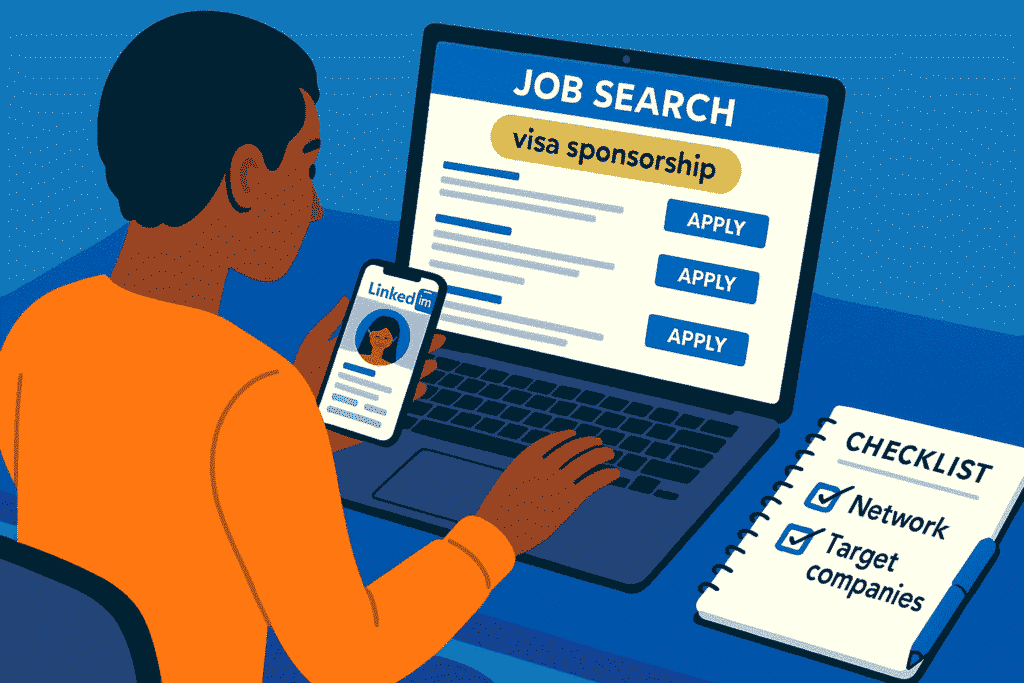
Landing a job in America with visa sponsorship requires a strategic approach that goes beyond simply submitting applications. With competition fierce for these coveted positions, you’ll need to leverage every available resource and tactic to stand out from the crowd. Here’s how to maximize your chances of securing employment with visa support in 2025.
Mastering Job Portals with Visa Sponsorship Filters
Major job platforms have become invaluable tools for international candidates, with advanced filtering options that can save you countless hours of searching. LinkedIn’s job search function now includes a dedicated “visa sponsorship” filter that instantly surfaces opportunities from employers willing to support work authorization. Similarly, Indeed and Glassdoor allow you to search specifically for jobs in the USA that offer sponsorship, though you may need to use slightly different keyword combinations like “H-1B sponsorship” or “work visa support.”
When using these platforms, it’s crucial to optimize your profile with keywords that recruiters search for. Include phrases like “requires visa sponsorship” or “seeking H-1B employer” in your summary section. Many corporate recruiters actively search for international talent using these exact terms, so making your status clear can help opportunities find you rather than the other way around.
Building Your Professional Network Strategically
In the American job market, who you know often matters as much as what you know—especially for visa sponsorship positions. Start by connecting with alumni from your university who now work in the US, as they’re often particularly willing to help fellow international graduates. Attend virtual and in-person industry events through platforms like Meetup and Eventbrite, focusing on gatherings in your target field.
LinkedIn networking should be approached methodically. Rather than sending generic connection requests, personalize each message by mentioning shared interests or experiences. Once connected, engage regularly with your contacts’ posts before asking for advice or referrals. Many professionals are more willing to recommend someone they’ve seen actively contributing to industry discussions than a complete stranger.
Targeting Visa-Friendly Employers Effectively
Researching companies with strong sponsorship histories significantly improves your odds of success. Beyond the obvious tech giants, look for mid-size companies in industries facing talent shortages. Healthcare systems, engineering firms, and certain manufacturing companies often have less competition for visa slots than household-name corporations.
When applying to these companies, tailor your resume and cover letter to address visa concerns proactively. Highlight any US work experience (including internships), emphasize specialized skills that are hard to find locally, and demonstrate cultural adaptability. Many employers worry about the complexity of sponsorship—showing you understand the process and are worth the effort can make all the difference.
For those currently studying in America, our guide on Can international students work in the USA after graduation? provides specific strategies for leveraging your student status into full-time employment. If you’re looking beyond temporary work authorization, our comprehensive resource on Green Card sponsorship jobs in the USA 2025 outlines long-term career pathways to permanent residency.
Remember that finding visa sponsorship requires persistence and patience. Set up job alerts, follow target companies’ career pages, and consider working with specialized recruitment agencies that understand immigration processes. With the right combination of preparation, networking, and strategic applications, you can significantly improve your chances of launching your American career.
Tips for a Strong Job Application
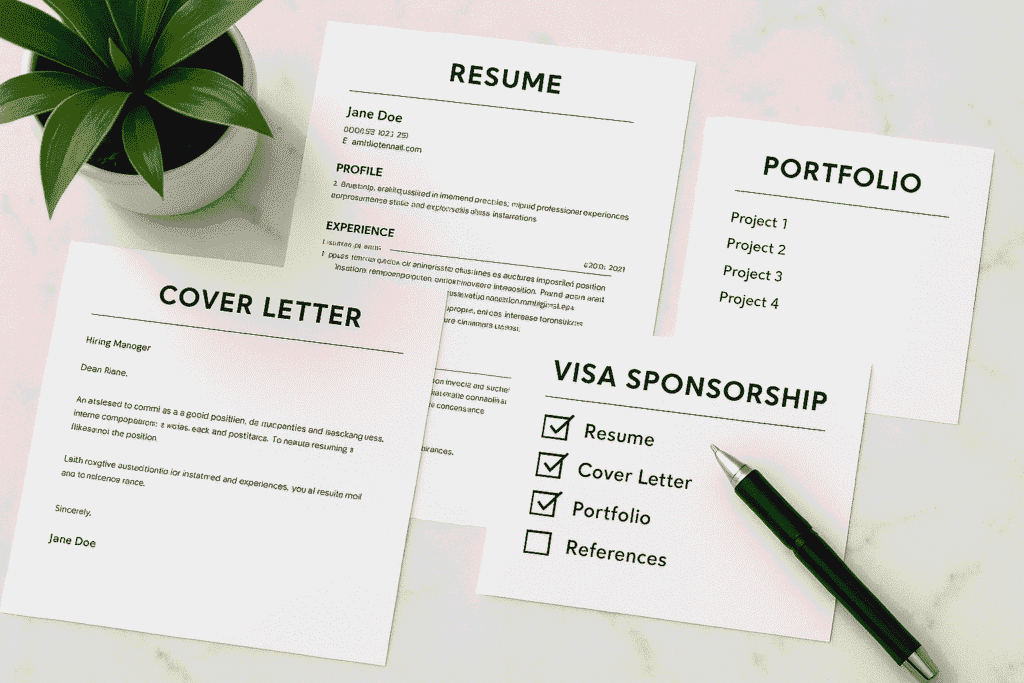
Securing a job in the USA with visa sponsorship requires more than just qualifications—it demands a carefully crafted application that addresses employers’ unique concerns. As competition intensifies for these coveted positions, your application materials need to simultaneously showcase your professional value while proactively handling sponsorship considerations.
Tailoring Your Resume for the American Market
American employers evaluating international candidates look for specific elements that demonstrate you’ll thrive in their work environment. Start by reformatting your resume to follow US conventions—typically a clean one-page layout for early-career professionals or two pages for senior candidates. Focus on quantifiable achievements rather than responsibilities, using action verbs and metrics that showcase your impact.
Crucially, emphasize skills that are in high demand but short supply domestically. For tech roles, this might mean highlighting specialized programming languages or niche technical expertise. In healthcare, stress any US-equivalent certifications or experience with American medical systems. Always research the specific keywords employers in your field use and incorporate them naturally throughout your resume.
The Art of Writing a Sponsorship-Focused Cover Letter
Your cover letter presents the ideal opportunity to address the sponsorship question head-on while positioning yourself as worth the investment. Open with a compelling narrative that connects your background to the company’s needs, then dedicate a paragraph to explaining your visa status clearly and confidently.
A strong approach might sound like, “As an international professional requiring work authorization, I bring [X unique qualifications] that align perfectly with your needs for [Y specialized skills].” I’m impressed by [Company’s] history of supporting diverse talent through visa sponsorship, and I’m confident my [specific achievements] would deliver immediate value to your team.”
Demonstrate your understanding of the sponsorship process by mentioning any previous US work experience (including internships or OPT), which shows you’re already familiar with American workplace culture. For those transitioning from student visas, our guide on Can international students work in the USA after graduation? offers specific strategies to highlight in your application.
Mastering the Visa Sponsorship Interview Conversation
When interviewers ask about your work authorization status, respond with prepared, positive framing: “I do require visa sponsorship, and I’ve researched [Company’s] successful history of supporting professionals like myself. I’m particularly excited about this opportunity because [specific reason], and I’m confident my [unique qualifications] would make the sponsorship process worthwhile for your organization.”
Prepare concrete examples of how you’ve adapted to new work environments or bridged cultural gaps in previous roles. For technical positions, be ready to solve problems on the spot to prove your capabilities transcend any concerns about immigration status.
Remember to research the company’s specific visa sponsorship patterns using resources like our Green Card Sponsorship Jobs in the USA 2025 guide. If you discover they frequently sponsor certain visa types, you might mention, “I understand you’ve successfully sponsored H-1B visas for similar positions, and I meet all the requirements for this pathway.”
By addressing sponsorship proactively while emphasizing your unique value proposition, you transform what some employers see as a hurdle into evidence of your thorough preparation and commitment to contributing to their organization’s success.
Challenges Faced by Immigrants in the US Job Market

While America remains a land of opportunity for skilled professionals worldwide, international job seekers face unique obstacles when pursuing careers in the United States. The first step in creating successful solutions to overcome these obstacles is comprehending them.
The Grueling Reality of Visa Processing Delays
The H-1B visa lottery system continues to create significant uncertainty for foreign professionals seeking jobs in the USA. In 2025, with application numbers consistently exceeding the 85,000 annual cap, many qualified candidates find themselves caught in lengthy processing backlogs. Premium processing options (which guarantee 15-day review for an additional fee) provide some relief, but even these expedited services can’t eliminate the fundamental scarcity of available visas.
These delays create a ripple effect throughout the hiring process. Employers often hesitate to make contingent offers knowing approval might take 6-9 months, while candidates face the stress of uncertain timelines. The situation is particularly challenging for international students transitioning from OPT status, as their work authorization has strict expiration dates. Our guide on Can international students work in the USA after graduation? offers specific strategies for navigating this precarious transition period.
Intense Competition for Limited Sponsored Positions
The simple truth is that there are far more qualified international candidates than available visa-sponsored jobs in the USA. Tech hubs like Silicon Valley and financial centers like New York attract talent from every corner of the globe, creating fiercely competitive environments where employers can be extremely selective.
This competition manifests in several ways:
- Companies increasingly demand specialized skills or niche expertise before considering sponsorship.
- Salary expectations for sponsored positions often run lower than for domestic hires.
- The interview process tends to be more rigorous for visa-requiring candidates.
Professionals in fields with acute domestic shortages (like healthcare and certain engineering specialties) typically face somewhat less competition, as we detail in our [Green Card Sponsorship Jobs in USA 2025] analysis.
The Shifting Sands of Immigration Policy
Perhaps no challenge is more frustrating than the constant evolution of US immigration regulations. Policy changes enacted in 2024 continue to reshape the landscape in 2025, affecting everything from prevailing wage requirements to documentation standards. Even minor procedural adjustments at USCIS can dramatically impact approval timelines and success rates.
Recent developments international job seekers should monitor include:
- Revised STEM OPT extension requirements
- Changes to H-1B wage level classifications
- Evolving standards for specialty occupation definitions
- Adjustments to premium processing availability
These policy fluctuations create legitimate anxiety, but they also reward those who stay informed. Following reputable immigration news sources and consulting with experienced attorneys can help you anticipate changes before they impact your job search.
While these challenges are real, they’re not insurmountable. Thousands of international professionals successfully navigate this system each year by combining persistence, preparation, and strategic targeting of opportunities. The key is approaching your job search with clear-eyed understanding of these obstacles while maintaining focus on the substantial rewards that await those who persevere.
Future Outlook for Immigrant Employment
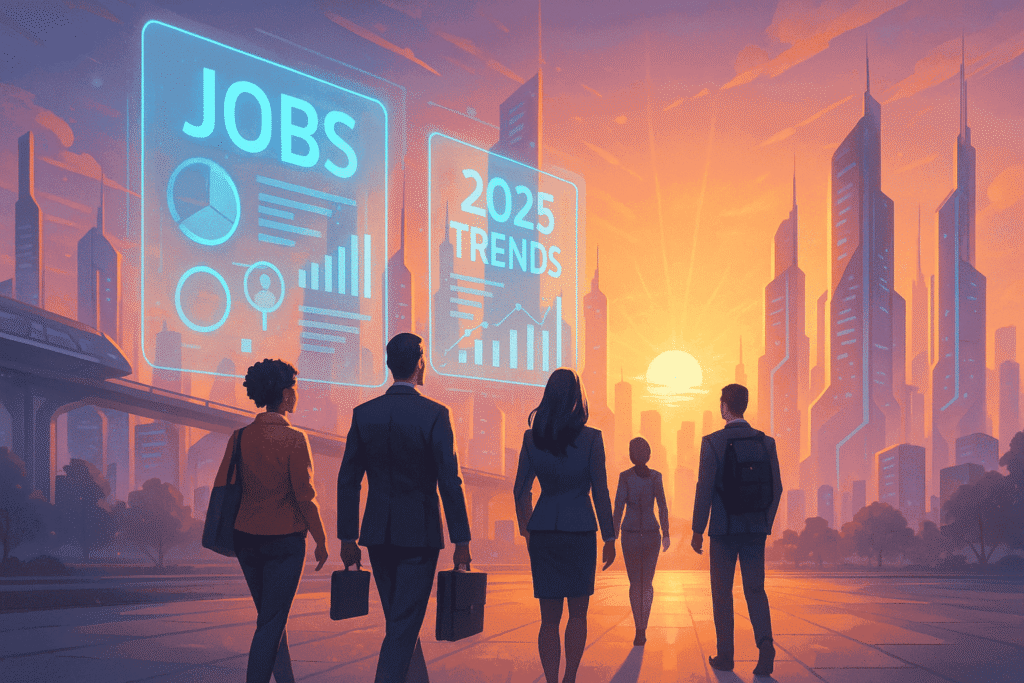
The American workforce landscape is undergoing a significant transformation, with skilled immigrants playing an increasingly vital role in maintaining the nation’s competitive edge. As we look toward the future of jobs in the USA, several key trends are emerging that will shape opportunities for foreign professionals in the coming years.
The Growing Dependence on Global Talent
Demographic shifts and specialized labor shortages are making immigrant workers more essential than ever to the US economy. By 2025, the technology sector alone is projected to face a shortage of nearly 1 million skilled workers, particularly in emerging fields like artificial intelligence, quantum computing, and cybersecurity. Similarly, the healthcare industry continues to grapple with critical staffing gaps, especially in nursing and specialized medicine.
These shortages create tremendous opportunities for international professionals with the right qualifications. Companies that recognize this reality and invest in robust visa sponsorship programs are positioning themselves to:
- Access a broader, more diverse talent pool.
- Fill critical skill gaps more efficiently.
- Gain competitive advantages in innovation-driven markets.
- Build globally-minded teams that understand international markets.
The Rising Value of Green Card Sponsorship
Forward-thinking Employers are increasingly recognizing that offering Green Card sponsorship jobs in the USA provides significant long-term benefits. While the initial investment is greater than temporary visa sponsorship, companies that help employees transition to permanent residency enjoy:
- Improved Retention Rates—Employees with permanent status are 3-5 times less likely to leave within 3 years compared to those on temporary visas.
- Enhanced Loyalty—Workers who receive sponsorship often develop strong organizational commitment.
- Competitive Recruitment Advantage—The promise of permanent residency helps attract top-tier global talent.
- Reduced Administrative Burden—Permanent employees don’t require ongoing visa renewals or status monitoring.
This shift is particularly evident in the tech industry, where leading firms now include Green Card sponsorship as a standard benefit for many positions, similar to healthcare coverage or retirement plans.
Emerging Opportunities in Unexpected Sectors
While technology and healthcare continue to dominate visa sponsorship statistics, several other industries are showing increased openness to hiring foreign workers:
Renewable Energy—As the US accelerates its transition to clean energy, demand is surging for engineers and technicians with expertise in solar, wind, and battery technologies. Many of these specialized skills are in short supply domestically.
Advanced Manufacturing—The reshoring of semiconductor and electronics production has created urgent needs for skilled workers in several states receiving federal infrastructure investments.
Agricultural Technology—The intersection of farming and technology is creating demand for professionals with unique combinations of agronomy and data science skills.
For international students considering their options, our guide on Can international students work in the USA after graduation? provides insights into how to position yourself for these emerging opportunities. Those interested in long-term career planning will find valuable information in our Green Card Sponsorship Jobs in the USA 2025 analysis.
The Path Forward
While immigration policy debates continue in Washington, the fundamental economic reality remains unchanged: America needs skilled foreign workers to maintain its global leadership in innovation and economic growth. Professionals who combine technical expertise with cultural adaptability and strong communication skills will find themselves well-positioned to capitalize on these trends.
The most successful candidates will be those who:
- Stay informed about evolving immigration policies.
- Target industries with demonstrated labor shortages.
- Develop niche skills that are difficult to find domestically.
- Build professional networks that can provide referrals and recommendations.
As we move further into the decade, the companies that thrive will be those that recognize the strategic value of global talent and make meaningful investments in visa and Green Card sponsorship programs. For skilled immigrants, this creates unprecedented opportunities to build rewarding, long-term careers in the United States.
Frequently Asked Questions (FAQs)
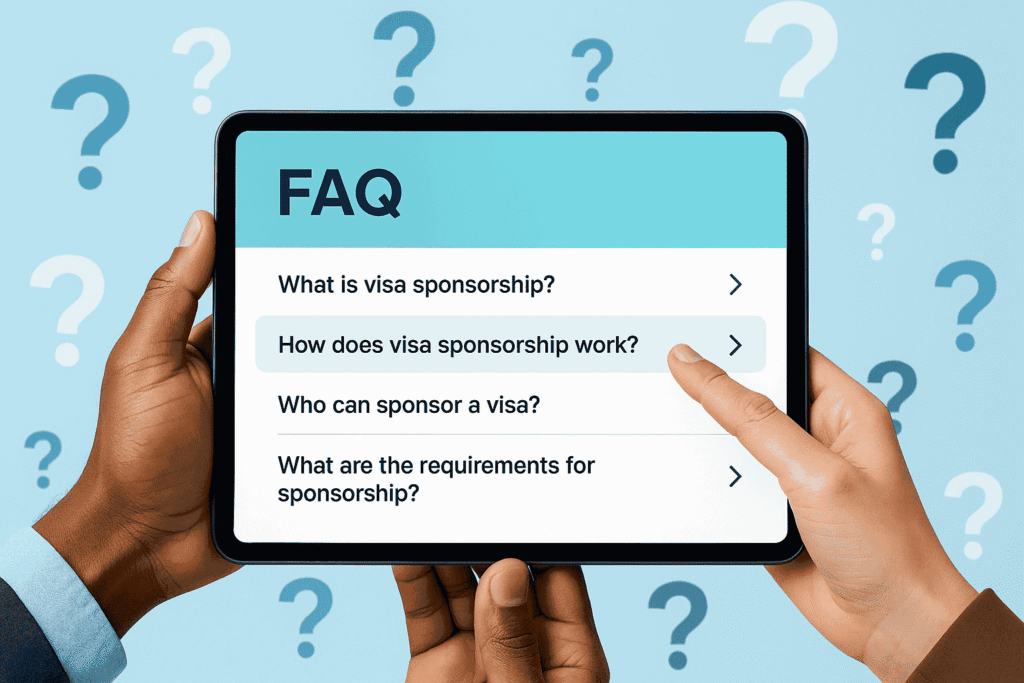
Can international students work in the USA after graduation?
Yes, international students can work in the USA after graduation through Optional Practical Training (OPT), which allows 12 months of employment authorization. STEM degree holders may qualify for a 24-month extension, providing up to 3 years of work experience. This transitional period is crucial for securing long-term visa sponsorship. Learn more about post-graduation work options in our detailed guide Can international students work in the USA after graduation?.
Which companies are most likely to sponsor Green Cards?
Leading technology firms (Google, Microsoft, Amazon), healthcare organizations (Mayo Clinic, Kaiser Permanente), and Fortune 500 companies across various industries regularly sponsor Green Cards for qualified employees. These employers typically have dedicated immigration teams to handle the complex process. Our comprehensive list of Green Card sponsorship jobs in the USA 2025 provides specific company examples and strategies.
How much time does it usually take to sponsor a visa?
Processing times vary significantly by visa type:
- H-1B visas: 3-6 months with premium processing
- L-1 transfers: 1-3 months
- Green Cards: 1–5 years, based on the country of origin and category
These timelines can fluctuate based on USCIS caseloads and policy changes.
What’s the difference between H-1B and L-1 visas?
The H-1B is for specialty occupation workers with at least a bachelor’s degree, while the L-1 facilitates intracompany transfers for employees who’ve worked abroad for at least one year. L-1 visas often have faster processing and no annual caps but require existing employment with a qualifying company.
Can I apply for jobs in the USA while still living abroad?
Absolutely. Many multinational companies conduct virtual interviews and will handle visa paperwork for successful international candidates. However, you’ll typically need to specify your visa requirements early in the application process.
What percentage of salary do employers typically pay for visa sponsorship?
Costs vary but often total $5,000-$15,000 in legal and filing fees for H-1B visas. While employers technically cover these costs, some may adjust salary offers accordingly. Employers may have to pay between $10,000 and $25,000 over a number of years to sponsor a green card.
Are there certain US states that offer better opportunities for visa sponsorship?
California, Texas, New York, Washington, and New Jersey consistently lead in visa sponsorships due to their concentration of tech companies, healthcare systems, and financial institutions. However, some smaller markets offer excellent opportunities with less competition.
How can I improve my chances of getting visa sponsorship?
Specialized skills, US work experience (even internships), advanced degrees, professional certifications, and demonstrated English proficiency all strengthen your case. Networking with employees at target companies can also provide crucial referrals.
Can my spouse work if I get an H-1B visa?
H-4 visa holders can work if the primary H-1B holder has an approved I-140 petition or has extended their status beyond the six-year limit. This makes the H-1B particularly attractive for couples.
What happens if my H-1B isn’t selected in the lottery?
Options include
- Pursuing employment with cap-exempt organizations (universities, nonprofits)
- Exploring other visa categories (O-1, L-1 if eligible)
- Gaining additional experience abroad and reapplying
- Considering positions in countries with easier US transfer options (Canada, Mexico)
How does the PERM labor certification process work for green cards?
Employers must prove they couldn’t find qualified US workers through recruitment efforts before sponsoring a foreign worker for permanent residency. This process typically takes 12-18 months before even filing the Green Card application.
Are there age limits for work visa applicants?
No strict age limits exist, but older applicants may face additional scrutiny to prove they aren’t nearing retirement age. The key is demonstrating you’ll provide substantial working years to justify the sponsorship investment.
What’s the best job search strategy for finding visa sponsorships?
Combine multiple approaches:
- Target known sponsor companies.
- Use visa-specific job filters on LinkedIn/Indeed.
- Attend industry networking events.
- Work with specialized recruiters.
- Highlight unique skills employers can’t find locally.
Can I change jobs after getting an H-1B?
Yes, through the H-1B portability process, but your new employer must file a new petition. This is easier after your initial petition is approved and you’ve started working.
How has the COVID-19 pandemic affected visa sponsorship?
While remote work options have expanded, most sponsored positions still require physical presence in the US. Processing delays continue in some categories, but demand for skilled foreign workers remains strong across key industries.
Each individual’s situation is unique, so consulting with an experienced immigration attorney is recommended when pursuing jobs in the USA with visa sponsorship. The landscape changes frequently, making it essential to stay updated on the latest policies and trends affecting foreign workers.
Final Thoughts
The journey to securing jobs in the USA with visa sponsorship is undoubtedly challenging, but for thousands of determined professionals each year, it leads to rewarding careers in the world’s largest economy. As we’ve explored throughout this guide, success in the American job market as an international candidate requires a thoughtful, multi-pronged approach that combines careful research, persistent effort, and strategic relationship-building.
For skilled immigrants targeting jobs in the USA with work authorization, the key lies in understanding where your unique qualifications intersect with America’s most pressing labor needs. The technology sector continues to offer the highest number of H-1B visa opportunities, particularly for specialists in artificial intelligence, cloud architecture, and cybersecurity. Healthcare professionals, especially those willing to work in underserved areas, find relatively smoother paths to employment authorization. Meanwhile, the infrastructure boom has created strong demand for engineers across multiple disciplines.
What separates successful candidates isn’t just technical skill but their ability to navigate the complex ecosystem of US immigration employment. This means
- Developing a targeted list of companies with proven sponsorship histories (like those we highlighted in our Green Card Sponsorship Jobs in the USA 2025 guide)
- Crafting application materials that simultaneously showcase your professional value and address sponsorship concerns
- Building authentic professional networks that can provide referrals and insider advice
- Staying current on policy changes that might affect your visa options
For international students beginning this journey, remember that your OPT period represents a golden opportunity to prove your worth to potential sponsors. Our resource on Can international students work in the USA after graduation? provides specific strategies to maximize this transitional phase.
While the road to US employment authorization requires patience and perseverance, the professional rewards can be substantial. Beyond competitive salaries, many visa-sponsored positions offer:
- Access to cutting-edge projects and technologies
- Opportunities for career advancement difficult to find elsewhere
- Potential pathways to permanent residency
- Exposure to diverse, global professional networks
Remember that every successful immigrant professional in America today once stood where you are now. By combining your unique talents with the strategic approaches outlined in this guide, you position yourself to join their ranks. The process may test your resolve at times, but for those who persist, the payoff—building a fulfilling career in the United States—makes every effort worthwhile.

